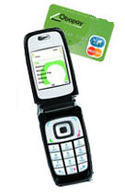 Obopay and PayPal both offer phone-and-text based payments along with a linked debit card for spending the money sitting in your payments account. But it's not as powerful as a true mobile wallet with a cellphone preprogrammed to connect to online banking and various payment options.
Obopay and PayPal both offer phone-and-text based payments along with a linked debit card for spending the money sitting in your payments account. But it's not as powerful as a true mobile wallet with a cellphone preprogrammed to connect to online banking and various payment options.
Here are the specs of the perfect mobile wallet:
- One-key access to common banking functions: check account balances, confirm transactions, and so on
- Money movement between the user's own accounts
- Send money to others using the bank's bill pay system or inter-institution funds transfer (A2A)
- Pay for purchases at the point of sale (debit card or credit card) using an embedded RFID chip
- Authenticate users at ATMs, branches, and remote terminals
- Person-to-person payments (potentially by linking to the PayPal network)
- Text message data entry: Update bank account records by sending a text message to the bank (for example, if you paid $22 cash for a business lunch, text to the bank, "22.00 biz lunch" which would be posted to your transaction records)
- Priority customer service: Voice, text, or IM customer service with minimum wait times with transcripts emailed for future reference
- Text-message-based alerts
- Real-time virtual "panic button" to disable phone: If the phone is misplaced, users should be able to temporarily disable payment and banking functions with a simple email or phone call to an automated system
Where will users purchase their mobile wallets?
While first-generation mobile wallets will come from tech startups, wireless phone companies, and Internet giants such as Google, a bank-based model has a number of potential benefits:
1. Trust
2. Integrated online banking features (balance lookup, transaction history)
3. Integrated bill payment (use pre-existing bill-pay merchants)
4. Mobile payment transaction history integrated with online banking history
As cool it sounds, mobile wallets will not replace cash or plastic until RFID-equipped POS terminals are widespread. Until then, you'll still need to carry plastic. That brings to mind a practical interim solution, a plastic clip that attaches an RFID-enabled mini-credit card to the back of a cell phone. Users would have the convenience of waving their cell phone to pay, but could also easily swipe the mag stripe through a conventional terminal.
— JB